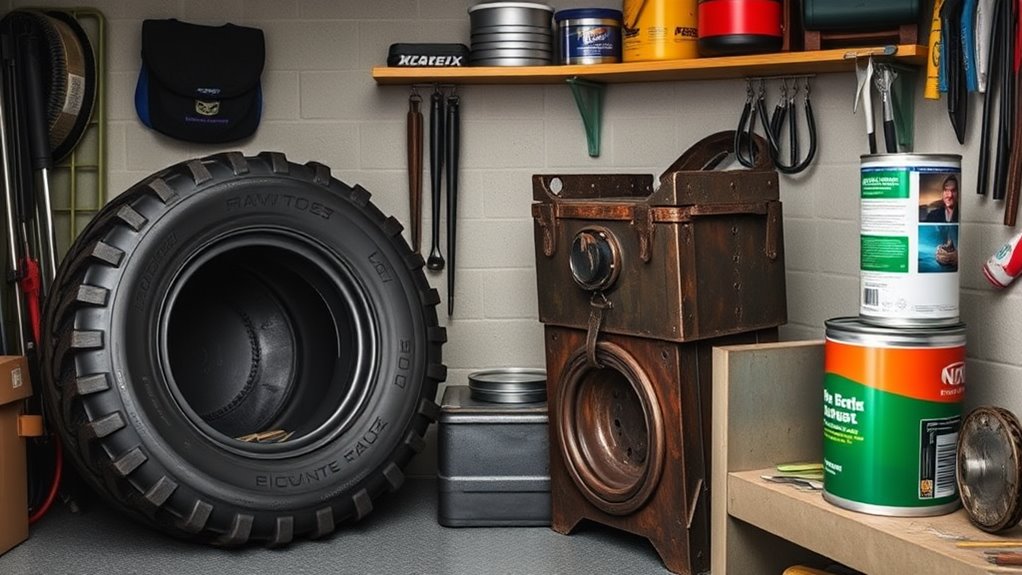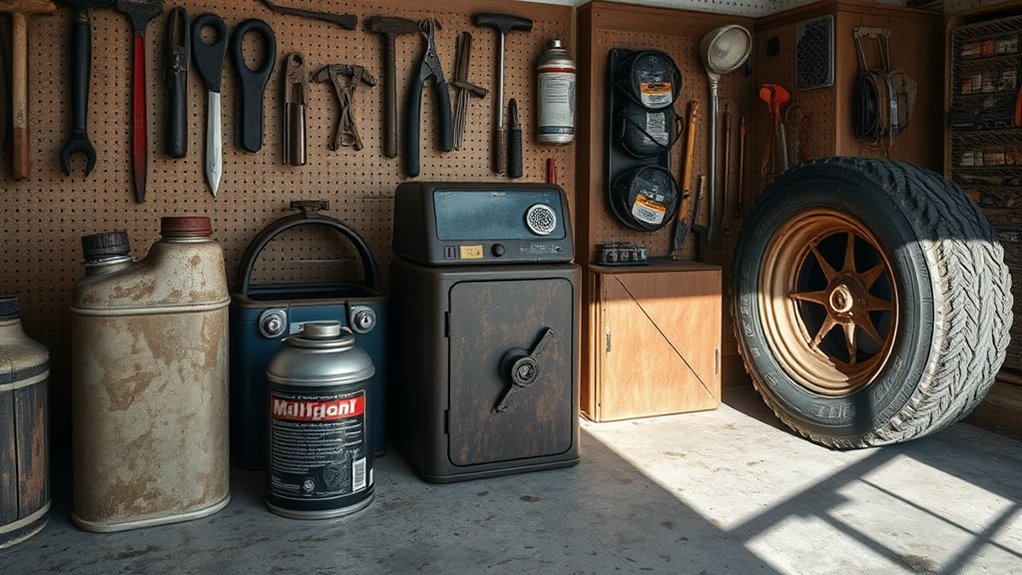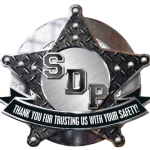Consider using diversion safes in your garage to keep your valuables secure and hidden. These safes cleverly disguise themselves as everyday garage items like canisters of motor oil or wall outlets, making them an excellent theft deterrent. They're easy to integrate with your garage's clutter, often overlooked by thieves who expect only tools. Opt for options like bolt safe designs that blend naturally while offering practical concealment. Installing them is straightforward, and regular maintenance guarantees long-term reliability. With cost-effective and versatile options available, they'll enhance your overall security strategy. Interested in maximizing your garage security? There's much more to discover.
Key Takeaways
- Diversion safes are concealed storage items designed to hide valuables within common garage objects, deterring theft.
- Popular options include fake electrical outlets, can safes, and bolt/nut safes, seamlessly blending with garage clutter.
- These safes provide cost-effective security, reducing burglary risk by disguising valuables as everyday items.
- Strategic placement near entrances or high-traffic areas enhances accessibility and convenience.
- Regular maintenance, including cleaning and rust prevention, ensures diversion safes remain effective and secure.
Types of Diversion Safes

When it comes to selecting diversion safes for your garage, there are, indeed, a variety of clever options to evaluate. You'll find that each type offers unique hidden compartments and creative designs to keep your valuables discreetly protected.
One popular option is the fake electrical outlet safe. These blend seamlessly into your garage's walls, providing a hidden compartment for small items like jewelry or cash.
You can also consider a can safe, resembling common household products like motor oil or paint cans, which are perfect for blending in with other garage supplies. A Coors Light Can Safe is ideal for disguising valuables in plain sight due to its resemblance to a standard beverage can.
Another innovative choice is the wall clock safe. It functions just like a regular clock but includes a secret compartment behind the face to store your essentials.
For tool enthusiasts, a diversion safe disguised as a bolt or a nut can be an excellent addition. These creative designs use the natural clutter of a garage to their advantage, ensuring no one will suspect your secret storage.
A popular option is the Engine Degreaser safe, which features a hidden storage compartment accessible by unscrewing the bottom, making it an ideal choice for storing small valuables.
Benefits of Garage Use
In the context of home security, using diversion safes in your garage offers numerous advantages. First and foremost, they provide effective theft prevention by disguising your valuables as everyday items. Burglars often overlook garages, assuming they're filled with tools and car parts, not realizing you've cleverly hidden storage solutions in plain sight. This approach keeps your valuables protected without drawing attention. Moreover, garages are typically cluttered with various objects, making it easier to blend in a diversion safe seamlessly. Whether you choose a fake can of motor oil or a box labeled "spare parts," you can easily incorporate these safes into your garage setup. The key is to make them indistinguishable from your regular items, enhancing their effectiveness. Additionally, having hidden storage in your garage allows you to keep essential documents, cash, or jewelry close by without the need for a traditional safe. One example of such a product is the Pepper Diversion Safe, which mimics the appearance of a regular soda can to conceal valuables discreetly. Furthermore, the Peanut Butter Diversion Safe offers a larger storage capacity than most diversion safes, making it ideal for securing larger valuables in a discreet manner in your garage. This accessibility is especially beneficial if your garage connects directly to your home.
Choosing the Right Safe

Selecting the right diversion safe for your garage is essential to maximizing security and convenience. Start by considering the material selection. Choose a safe with durable, high-quality materials that can withstand garage conditions. Metals like steel are excellent for their strength and resistance to tampering.
If you're thinking about a plastic option, make sure it's robust enough to deter any attempts at forced entry. The material should also blend seamlessly with other garage items for effective camouflage.
Next, focus on size considerations. Think about what you'll be storing in the safe and how much space you'll need. A large safe can hold more items, but it must remain inconspicuous. Measure your available space and consider how the safe will fit among your garage's layout.
You don't want a safe that stands out or is hard to access. A compact, cleverly disguised option might be ideal if space is limited.
Also, assess the weight of the safe. A heavier safe might offer more security, but make sure it's not so cumbersome that it becomes impractical. Balancing size and material is key to finding a diversion safe that effectively meets your security needs without compromising convenience. Consider options like the Wall Socket Diversion Safe, which blends seamlessly into its environment while providing discreet storage.
Installation Tips
Proper installation is vital for guaranteeing your diversion safe effectively protects your valuables. Start by selecting a discreet location in your garage that won't draw attention. Consider places like behind shelves or within toolboxes where the safe can blend seamlessly into its surroundings.
When choosing installation techniques, verify they align with your garage's layout and the safe's design.
Before you begin, gather all necessary tools and materials. You don't want to interrupt the process to search for missing items. Depending on the type of diversion safe, you might need a drill, screws, or adhesive.
Follow the manufacturer's instructions carefully, as each safe might've specific requirements.
Safety precautions are essential during installation. Wear protective gear like gloves and goggles to prevent injuries. If you're drilling into walls or floors, double-check for any hidden wires or pipes to avoid damaging your home's infrastructure.
If you're uncertain about any step, consider consulting a professional for assistance.
Once installed, test the safe to confirm it's secure and functional. Make sure the locking mechanism works smoothly, and the safe remains well-hidden.
A well-installed diversion safe offers peace of mind, knowing your valuables are safeguarded.
Maintenance and Care

Although diversion safes require minimal upkeep, regular maintenance guarantees they continue to protect your valuables effectively.
Start by incorporating cleaning routines into your schedule. Every few months, wipe down the exterior of your diversion safe with a soft, damp cloth to remove dust and grime. This helps maintain its inconspicuous appearance, assuring it blends seamlessly with other items in your garage.
Avoid using harsh chemicals or abrasive materials as they could damage the surface, making the safe less convincing.
Next, check the interior of your safe. Open it periodically to ascertain the locking mechanism works smoothly and that there's no moisture buildup, which can damage your valuables.
If you notice any rust or unusual wear, address it immediately to prevent further deterioration.
Consider your storage solutions carefully. Keep items like important documents in sealable plastic bags to protect them from potential moisture.
This not only preserves the contents but also makes it easier to organize and access them when needed.
Enhancing Overall Security
To bolster your garage's security, start by placing your diversion safe in an unexpected location. Thieves often target obvious spots first, so think creatively about where to hide your valuables. Consider unconventional areas like behind shelves or within toolboxes, providing effective hidden storage that keeps your items safe from prying eyes. By using such innovative placements, you greatly enhance theft prevention.
Next, reinforce your garage's entry points. Secure doors with deadbolts and use motion-detecting lights to deter potential intruders. A well-lit, fortified entrance makes it challenging for thieves to enter unnoticed, giving you peace of mind.
Combining these measures with your diversion safe creates a robust security system that protects your belongings.
Additionally, consider integrating technology into your security plan. Install a security camera system that covers all angles of your garage, giving you real-time access and notifications. Link the camera to your smartphone so you can monitor activity remotely.
This technological edge, combined with the strategic use of diversion safes, enhances overall security and minimizes risks.
Frequently Asked Questions
Are Diversion Safes Legal to Use in All States?
You might wonder if they're legal in every state. While generally yes, you should always check state regulations because legal implications can vary. Staying informed guarantees you won't face unexpected issues using them.
Can Diversion Safes Protect Against Fire or Water Damage?
You're wondering if diversion safes offer fire resistance or waterproofing. They typically don't provide significant protection against fire or water damage. Consider additional measures for valuables if you're concerned about these risks in your storage solution.
Are There Specific Brands Recommended for High-Value Items?
You've searched the world over for the best high-value storage options. Brand comparisons reveal Fort Knox and SentrySafe as top picks. They offer unmatched security, ensuring your treasures are as safe as a dragon's hoard.
How Do I Ensure My Diversion Safe Blends in Seamlessly?
To guarantee your safe blends in seamlessly, focus on camouflage techniques. Choose a location that matches its appearance naturally. Safe placement is key; embed it among similar items to avoid drawing attention and maintain security.
What Are Common Mistakes to Avoid When Using a Diversion Safe?
When using a diversion safe, don't assume it's foolproof. Common misconceptions include thinking it's invisible or forgetting realistic usage scenarios. Always guarantee it fits naturally into its surroundings and regularly check that it's still secure.




